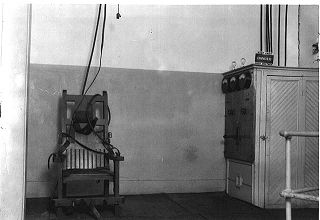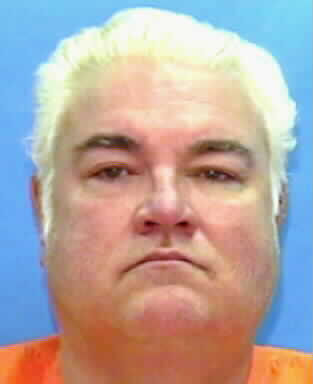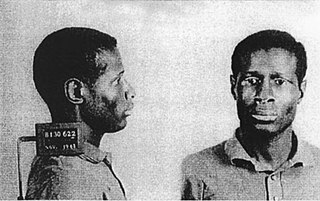
The electric chair is a specialized device used for capital punishment through electrocution. The condemned is strapped to a custom wooden chair and electrocuted via electrodes attached to the head and leg. Alfred P. Southwick, a Buffalo, New York dentist, conceived this execution method in 1881. It was developed over the next decade as a more humane alternative to conventional executions, particularly hanging. First used in 1890, the electric chair became symbolic of this execution method.

William Francis Kemmler was an American murderer who was the first person executed by electric chair. He was convicted of murdering Matilda "Tillie" Ziegler, his common-law wife, a year earlier. Although electrocution had previously been successfully used to kill a horse, Kemmler's execution did not go smoothly.

Sing Sing Correctional Facility, formerly Ossining Correctional Facility, is a maximum-security prison operated by the New York State Department of Corrections and Community Supervision in the village of Ossining, New York, United States. It is about 30 miles (48 km) north of Midtown Manhattan on the east bank of the Hudson River. It holds about 1,700 inmates and housed the execution chamber for the State of New York until the abolition of capital punishment in New York in 2007.

Capital punishment is a legal penalty in the U.S. state of Ohio, although all executions have been suspended indefinitely by Governor Mike DeWine until a replacement for lethal injection is chosen by the Ohio General Assembly. The last execution in the state was in July 2018, when Robert J. Van Hook was executed via lethal injection for murder.

Old Sparky is the nickname of the electric chairs in Arkansas, Connecticut, Florida, Georgia, Illinois, Kentucky, Nebraska, New York, Ohio, Oklahoma, South Carolina, Texas, Virginia, and West Virginia. Old Smokey was the nickname of the electric chairs used in New Jersey, Pennsylvania, and Tennessee. "Old Sparky" is sometimes used to refer to electric chairs in general, and not one of a specific state.
Yellow Mama is the electric chair of the United States state of Alabama. It was used for executions from 1927 to 2002.

Gruesome Gertie was the nickname given by death row inmates to the Louisiana electric chair.

Allen Lee Davis was an American murderer who was executed for the 1982 murder of Nancy Weiler, who was three months pregnant, in Jacksonville, Florida. According to reports, Nancy Weiler was "beaten almost beyond recognition" by Davis with a .357 Magnum, and hit more than 25 times in the face and head. He was additionally convicted of killing Nancy Weiler's two daughters, Kristina, age 9, who was shot twice in the face, and Katherine, age 5, who was shot as she tried to run away and then had her skull beaten in with the gun.
Edwin F. Davis, of Corning, Steuben County, New York, was the first "state electrical engineer” (executioner) for the state of New York. In 1890, Davis finalized many features of the first electric chair used. Davis performed 240 executions between 1890 and 1914, including the first person to be executed by electric chair, William Kemmler, and the first woman, Martha M. Place, as well as William McKinley's assassin, Leon F. Czolgosz.
Auburn Correctional Facility is a state prison on State Street in Auburn, New York, United States. It was built on land that was once a Cayuga village. It is classified as a maximum security facility.
Robert Greene Elliott was the New York State Electrician (i.e., executioner) – and for those neighboring states that used the electric chair, including New Jersey, Pennsylvania, Vermont, and Massachusetts – during the period 1926–1939.

Eddie Lee Mays was the last person to be executed by the state of New York. He was convicted of first degree murder and robbery in 1962. Mays was 34 years old at the time of execution.

Nevada State Prison (NSP) was a penitentiary located in Carson City. The prison was in continuous operation since its establishment in 1862 and was managed by the Nevada Department of Corrections. It was one of the oldest prisons still operating in the United States. The high security facility housed 219 inmates in September 2011. It was designed to hold 841 inmates and employed a staff of 211.
Dow B. Hover was an American executioner who was the last person to serve as a New York State Electrician, the state's executioner and operator of the electric chair. He was the last person to serve as an executioner in the state, which has since abolished the death penalty. On August 15, 1963 at Sing Sing prison, Hover executed Eddie Lee Mays, the last person to be executed by the State of New York.

Capital punishment was outlawed in the State of New York after the New York Court of Appeals declared it was not allowed under the state's constitution in 2004. However certain crimes occurring in the state that fall under the jurisdiction of the federal government are subject to the federal death penalty.
John W. Hulbert Jr. was the executioner for the states of New York, New Jersey and Massachusetts from 1914 to 1926. Hulbert was trained as state electrician by his predecessor, Edwin F. Davis, and oversaw 140 electrocutions during his tenure.
Joseph Francel was an American electrician from Cairo, New York, who was the state of New York's executioner from 1939 until 1953.

George Edward Fell was an American surgeon and inventor. He was an early developer of artificial ventilation and also investigated the physiology of electrocution, a line of research that led to Fell creating the final design for the first electric chair.









